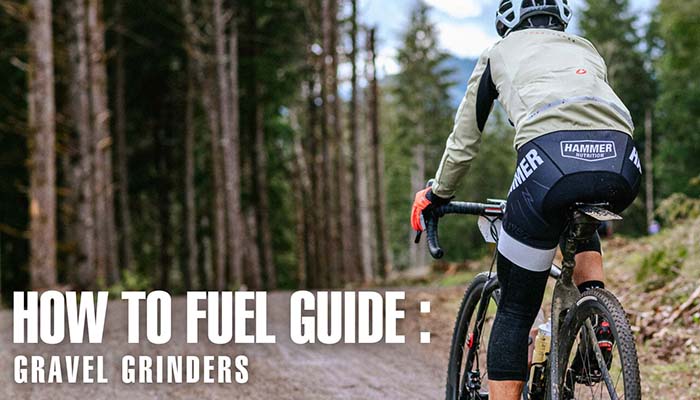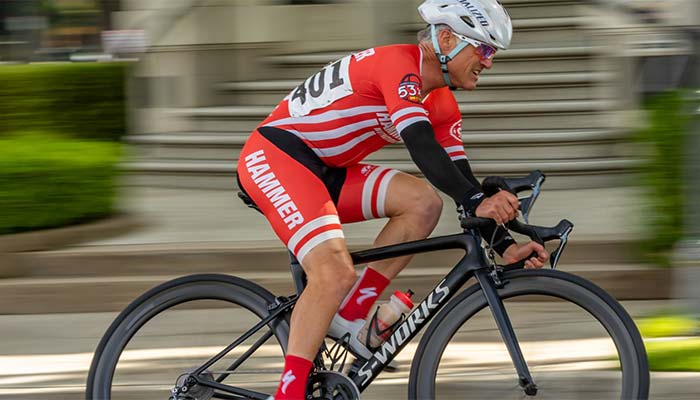
BY STEVE BORN
1.5-kilometer (0.93-mile) swim, 40-kilometer (25-mile) bike, 10-kilometer (6.2-mile) run
This step-by-step fueling protocol is super easy to put together, it’s just as easy to follow, it doesn’t require that you carry a ton of stuff on your bike or body, it will save you time, and, best of all, it’s highly effective.
Before you get to the fueling protocol, here is some very important and useful information...
5 Simple Ways to Improve Athletic Performance Now
While there are numerous steps that you can (and should) take to optimize athletic performance, here are a couple of super easy ones. Start with these right away and you’ll experience noticeably rapid improvement in your endurance.
1) Stay properly hydrated all day long. With approximately 60% of your body being comprised of water, it goes without saying that it’s vitally important to maintain optimal hydration status all day long. Unfortunately, a lot of people—perhaps you?—live in a state of perpetual dehydration, and that negatively affects athletic performance and overall health. Starting now, gradually increase your fluid intake—primarily from pure, clean water—so that the total number of ounces you’re drinking on a daily basis is equal to 0.5 to 0.6 of your body weight in pounds (e.g., 180-lb athlete should consume 90 – 108 ounces of fluids daily, in addition to what is being consumed during exercise). During exercise, drink 16-26 ounces per hour, and up to 28 ounces per hour during hot weather.
2) Fuel lean. It’s interesting to know how many calories you’re burning every hour during exercise; however, that amount isn’t really a factor in terms of how many calories your body can accept in return from your fuel donation. The goal of caloric intake is to consume the least amount necessary to maintain energy levels where you want and need them to be hour after hour. For the majority of athletes, this represents an intake of 120-180 calories per hour. Larger athletes (200+ lbs.) can consume 200-or-slightly-more calories. And if you find that’s not quite enough calories, that’s an easy fix—you simply consume a few more. Remember, it is ALWAYS easier to fix a “not enough” problem than an “uh oh, I overdid it and now my stomach is rebelling” problem.
3) Ditch the sugar. Some fuels are comprised of a combination of simple sugars (glucose, sucrose, fructose, etc.) and complex carbohydrates (maltodextrin), formulated under the premise that your body will be able to produce more energy on a per-minute basis using multiple carbohydrate sources compared to a single carbohydrate source. Remember, though, that the subjects in those “multi-carb” studies were exercising at such low intensities—a recovery pace, at best—that they could probably consume anything without issue. Instead, choose complex carbohydrates (maltodextrin), such as in Hammer Nutrition's Hammer Gel, HEED, Sustained Energy 2.0 or Perpetuem 2.0. Unlike simple sugars, complex carbohydrates provide quick-acting, longer-lasting energy and cause no stomach issues even at high intensity efforts.
4) Don’t eat for 3 hours prior to your workouts and races. By refraining from consuming any calories in the 3-hour period prior to your workouts and races, you put your body in the ideal physiological state to use its finite stores of muscle glycogen most efficiently, while also utilizing the vast amounts of calories from body fat stores more effectively. Adopt this practice in all your workouts—even the early morning ones—and you’ll start seeing massive improvements in your endurance in a relatively short time. Note: If you must have some calories prior to the start of exercise, consuming something that’s easy to digest (e.g., a serving of Hammer Gel) 5-10 minutes prior to the start—but no further out—is acceptable.
5) “Refill the tank” ASAP after all your workouts. Your body wants to reward you for the efforts you made in training, strengthening the immune system, rebuilding muscle tissue stronger, and storing more minutes of readily available fuel in the muscles. All you have to do to enjoy all of these endurance-enhancing benefits is supply your body with the materials it needs right away—ideally within the first 30 minutes after exercise (the sooner the better)—meaning complex carbohydrates and high-quality protein such as found in Recoverite and Vegan Recoverite.
FUELING RECOMMENDATIONS
1) Success "during" starts "after"! It’s absolutely vital that you "refill the tank" after all your workouts... this is a major key for noticeably enhancing athletic performance. When you begin a workout or event/race, the primary fuel your body uses for the first 60-90 minutes or so is known as muscle glycogen. The more consistent you are with ASAP post-exercise fueling—Recoverite or Organic Vegan Recoverite is ideal for that—among the many benefits you'll receive is more minutes of glycogen stored in the muscles—maxing out at somewhere between 60-90 minutes—ready to serve you in future workouts and races.
2) Finish all calorie consumption 3 hours prior to start. See #4 in the earlier article as to why this is so important.
3) “Pre-emptive strike” dose of Endurolytes or Endurolytes Extreme. Taking a dose of Endurolytes or Endurolytes Extreme 15-30 minutes prior to the start will cover your electrolytic mineral needs during the swim portion. The dose can be anywhere from 1-6 capsules per hour, with most athletes using 2-4 capsules an hour, the amount dependent on body weight and temperature conditions. If you’re competing in hot-weather conditions—and especially if you’re not very acclimated to those conditions—use Endurolytes Extreme at the rate of 1-2 capsules hourly, with the first dose taken 15-30 minutes prior to the start. If you prefer to drink your electrolytes versus taking capsules, add 1-3 tablets of Endurolytes Fizz or 1-2 scoops of Endurolytes Extreme Powder to your water bottle. Take sips from 30 minutes to 10 minutes prior to the race to cover your electrolytic mineral needs for the swim portion.
4) Consume 1-2 servings of Hammer Gel 5-10 minutes prior to the race. Consuming 1-2 servings of Hammer Gel at this time will supply some calories to augment muscle glycogen stores during the swim portion, but without interfering with the efficiency of how your body will use its finite stores of muscle glycogen as a fuel source.
5) At T-1. Consume a “pre-emptive strike” dose of Endurolytes or Endurolytes Extreme along with a drink from multi-hour fuel bottle (see below), washed down with water. A few seconds spent at the transition to replenish electrolytes and consume a few calories will more than repay you during the ride because it allows you to focus solely on establishing a smooth pedaling rhythm during that crucial initial portion of the bike phase. To expedite the process, have the Endurolytes or Endurolytes Extreme ready in a small container such as a Hammer Nutrition flip-top capsule dispenser. Again, if you prefer to drink your electrolytes versus taking capsules, 1-3 tablets of Endurolytes Fizz or 1-2 scoops of Endurolytes Extreme Powder added to your water bottles will be sufficient in fulfilling an hour’s worth of electrolytic mineral requirements.
5) Bike fuel. Because most athletes will complete the race in three hours or less, two bottles of HEED should be sufficient in fulfilling calorie needs, fluid needs, and most-to-all of electrolytic mineral needs. Carry some extra Endurolytes or Endurolytes Extreme in the event that you need additional electrolytic mineral support above and beyond what you’re receiving from HEED.
Each scoop of HEED contains 110 calories. I (Steve Born) personally use 1.75 scoops of Perpetuem 2.0 an hour, which supplies 192.5 calories, an amount that works well for larger athletes like me (I’m 200 pounds). For light-weight athletes, 1.0 scoop (110 calories) per hour works well. Medium-weight athletes will find that to 1.25 scoops (137.5 calories) to 1.50 scoops (165 calories) per hour is an excellent amount.
If your race is going to take you over 3 – 3.5 hours, use Perpetuem 2.0 or Sustained Energy 2.0 for you bike portion fuel.
Each scoop of Perpetuem 2.0 contains 90 calories. I (Steve Born) personally use 2.25 scoops of Perpetuem 2.0 an hour, which supplies 202.5 calories, an amount that works well for larger athletes like me (I’m 200 pounds). For light-weight athletes, 1.0 scoop (90 calories) to 1.25 scoops (112.5 calories) per hour works well. Medium-weight athletes will find that 1.50 scoops (135 calories) to 2.0 scoops (180 calories) per hour is an excellent amount.
Each scoop of Sustained Energy 2.0 contains 100 calories. I (Steve Born) personally use 2.0 scoops an hour, which supplies me with 200 calories. For light-weight athletes, 1.0 scoop (100 calories) to 1.25 scoops (125 calories) per hour works well. Medium-weight athletes will find that 1.50 scoops (150 calories) to 1.75 scoops (175 calories) per hour is an excellent amount.
6) At T-2. “Pre-emptive strike” dose of Endurolytes or Endurolytes Extreme. Before you transition from cycling muscles to running muscles, replenishing your body with some electrolytes is a good idea if your last dose of Endurolytes or Endurolytes Extreme was 30+ minutes prior to T-2. If it was only about 10-20 minutes or so prior to T-2 you can skip the dose at transition and start taking Endurolytes or Endurolytes Extreme during the run.
7) Run fuel. Hammer Gel (1 serving every 30-45 minutes) will cover your calorie needs, Endurolytes or Endurolytes Extreme will satisfy your electrolytic mineral requirements, and water only from the aid stations (no sugary sports drinks!) will fulfill your hydration needs.
8) ASAP after the race. “Refill the tank” ASAP with Recoverite or Vegan Recoverite. Refueling your body with two scoops of Recoverite within the first 30 minutes after your races takes advantage of the glycogen synthase enzyme when it’s most active. This allows the body to replenish and increase its stores of glycogen, while also providing the raw materials (the amino acids from protein) to help rebuild the muscle tissue and support the immune system.
Don’t Miss Out – Download Your 5 Free Secrets to Success Now!









